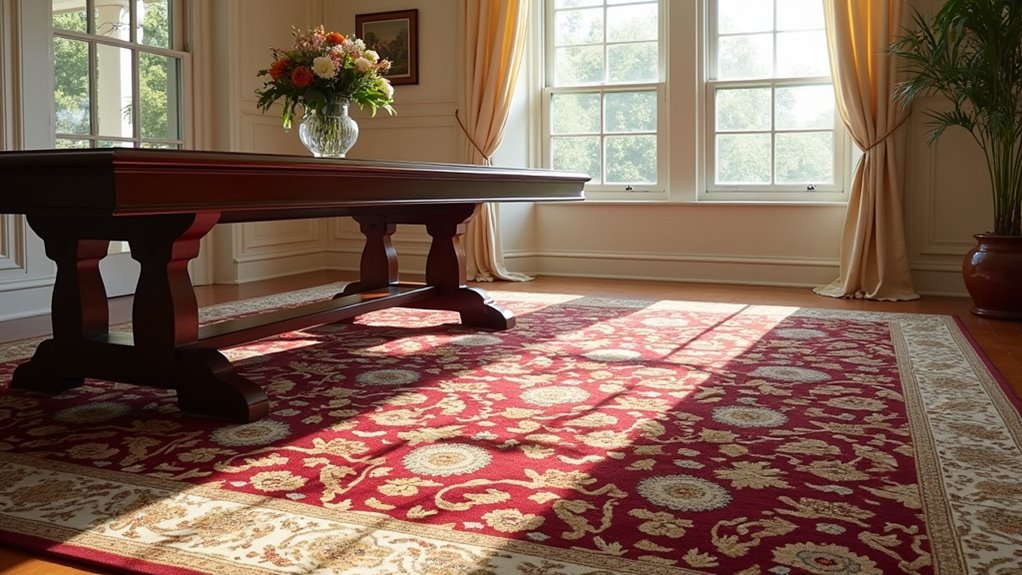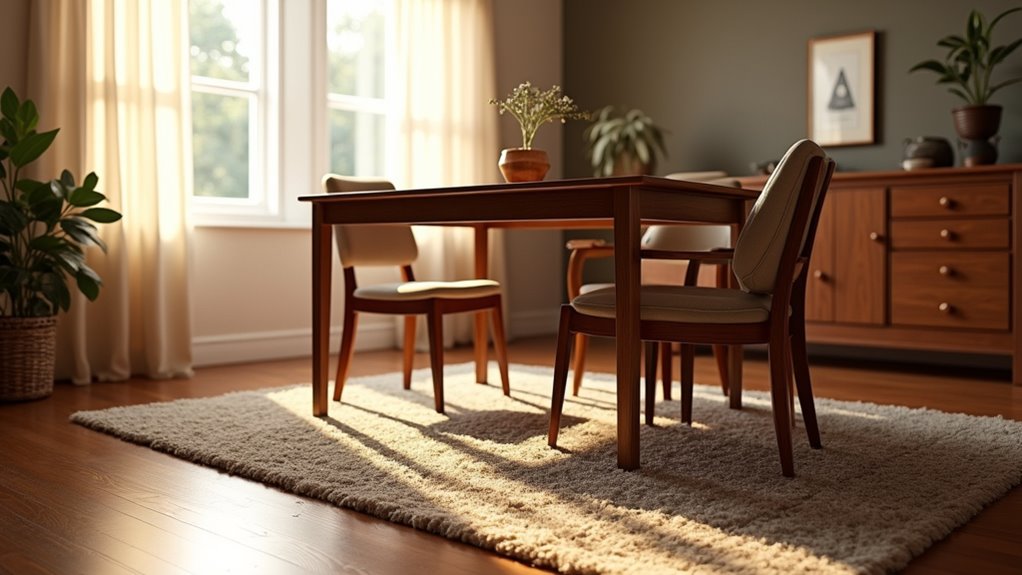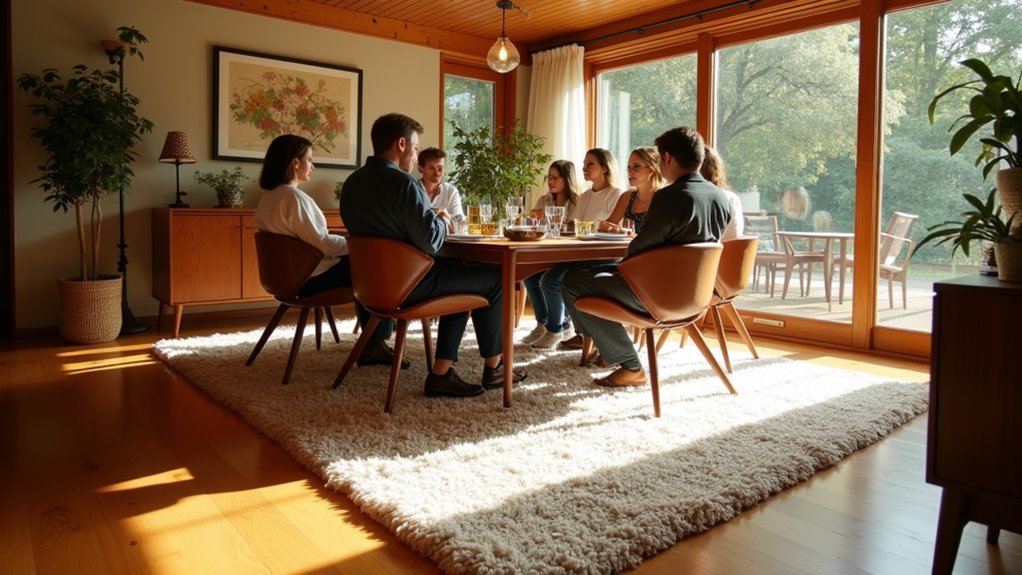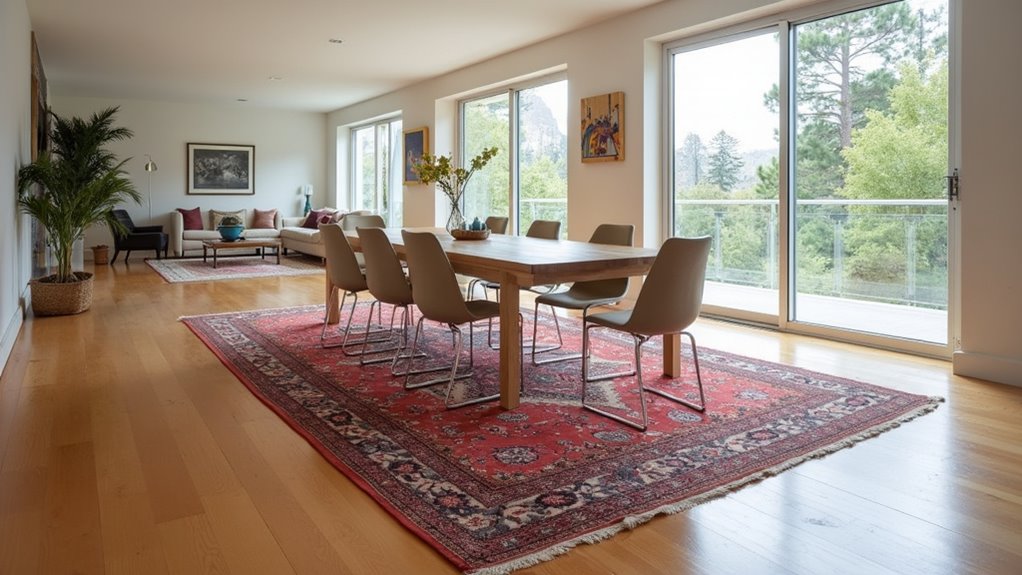Homeowners often weigh aesthetics, practicality, and acoustics when deciding on rugs for dining areas. Rugs enhance visual appeal, protect flooring from damage, and absorb sound, creating a serene dining environment. Proper sizing and placement are crucial for stability and room balance. The choice of material also affects durability and maintenance, influencing decisions further. For those seeking harmony in open spaces, rugs can define areas effectively. Further insights will illuminate the key factors to consider in this decision.
Key Takeaways
- People consider aesthetic appeal, using rugs to enhance the visual harmony and warmth of the dining area.
- Practicality is key; rugs protect flooring from chair movements, spills, and scratches.
- Acoustic benefits influence decisions, as rugs help reduce noise and create a serene dining atmosphere.
- Size and placement matter; a properly sized rug should extend beyond the table for stability and comfort.
- Material choice affects durability and maintenance, with preferences for wool or polypropylene depending on dining space usage.
Visual and Aesthetic Enhancements

How does the choice of a rug influence the overall aesthetic of a dining room? A carefully selected rug serves as a visual anchor, fostering color harmony while unifying diverse design elements. Bold or patterned rugs introduce visual interest, cleverly breaking monotony and emphasizing the dining area, while neutral tones maintain an elegant ambiance for minimalist designs. The rug’s color intensity is critical, ensuring it complements rather than overwhelms furniture and decor. Textured rugs enrich tactile experiences and provide contrast between hard surfaces and softer treatments. Additionally, the rug should delineate the dining zone, especially in open layouts, enhancing spatial definition and cohesion within the room’s overall design narrative. Rugs act as sound absorbers in dining areas, contributing to a more tranquil atmosphere, which also enhances the overall dining experience. These elements collectively elevate the dining environment, making it more inviting and visually appealing. Furthermore, a well-chosen rug can protect hardwood floors from scuffing and spills, adding both style and practicality to the dining space.
Practical Protection for Flooring

Practical protection for flooring in dining areas is critical to prevent damage from frequent chair movements and potential spills.
Implementing damage prevention strategies through the strategic placement of rugs can safeguard surfaces from scratches and scuff marks, ensuring long-term durability.
Additionally, selecting rugs with stain-resistant properties is essential, as these features mitigate the impact of accidents and preserve the aesthetic appeal of the dining space.
Damage Prevention Strategies
Protecting flooring from damage in dining areas requires a strategic approach to rug placement and maintenance.
Effective damage resistance involves understanding the interplay between furniture weight and flooring care.
Implementing the following strategies can preserve both rugs and floors:
- Utilize firm, thin padding to reduce dents from heavy furniture.
- Apply furniture coasters to evenly distribute weight and minimize fiber crushing.
- Regularly rotate rugs to enhance durability and prevent localized wear.
- Opt for durable rugs with tighter weaves that withstand the strain of dining activities.
Stain Resistance Importance
In the context of dining rooms, stain resistance stands as a crucial factor in safeguarding both rugs and the underlying flooring from the inevitable spills that accompany mealtimes. Effective stain prevention techniques, such as selecting the right fiber type and construction, offer significant durability considerations for rugs.
| Fiber Type | Stain Resistance | Durability Level |
|---|---|---|
| Wool | Natural resistance | Moderate |
| Nylon | Engineered implies | High |
| Polypropylene | Highly resistant | High |
Choosing stain-resistant rugs minimizes cleaning frequency, preserving the aesthetics of both the rug and floor. They play a vital role in enhancing the hygiene of dining areas, making them indispensable for families with children or pets.
Acoustic Benefits for a Better Atmosphere

Incorporating rugs into dining areas significantly enhances the acoustic environment, leading to a more enjoyable dining experience.
By effectively reducing noise levels and mitigating echoes, rugs foster a serene ambiance that promotes meaningful conversation among guests.
This improvement not only elevates the aesthetic appeal of the space but also encourages social interaction by creating a comfortable auditory atmosphere.
Noise Reduction Effects
While creating an inviting dining atmosphere, the choice of rugs plays a crucial role in enhancing both aesthetics and acoustics.
Effective noise reduction techniques can transform the dining experience through:
- Thicker Rugs: Plush, dense rugs absorb more sound, minimizing echoes from hard surfaces.
- Natural Fibers: These materials enhance sound absorption, which reduces ambient noise significantly.
- Rug Pads: Adding a pad underneath increases acoustic insulation, effectively dampening impact and airborne sounds.
- Layering: Combining rugs with soft furnishings amplifies noise control, ensuring a serene environment.
Enhanced Dining Ambiance
A thoughtfully chosen rug can significantly enhance dining ambiance, creating a more inviting atmosphere for social interactions and meals.
Rugs, made from dense, porous materials, absorb sound waves, reducing reflections and echo in dining spaces with hard flooring. By dampening ambient noise, rugs elevate dining experiences, fostering a more intimate and tranquil environment. This acoustic improvement not only enhances clarity in conversations but also mitigates auditory fatigue in multi-person settings.
In open-concept layouts or large dining areas, rugs effectively break up sound propagation, promoting better communication and auditory comfort.
Ultimately, the addition of a rug enriches sensory engagement, ensuring a pleasant and harmonious dining atmosphere that supports relaxation and conviviality among diners.
Size and Placement Considerations

Choosing the right size and placement for rugs in dining areas is essential to ensuring both functionality and aesthetic appeal. Properly selected rug dimensions enhance comfort while contributing to the room’s overall harmony.
To achieve this, consider the following:
- Extend Beyond the Table: Rugs should extend at least 24 inches beyond all sides of the dining table.
- Size Matters: For a dining table seating six, a rug of 8’x10′ ensures stability when chairs are pulled out.
- Proportional Fit: Allow 12 inches between the rug’s edge and nearby walls to avoid crowding.
- Shape Compatibility: Use rug shapes that correspond with the table for visual balance and ease of use.
These considerations ensure the dining space remains inviting and functional.
Choosing the Right Design and Material

Selecting the appropriate design and material for dining room rugs significantly influences both the visual harmony and practicality of the space.
Fiber selection is crucial; wool offers durability and stain resistance, while nylon provides superior maintenance ease, making them preferable for high-traffic areas.
Alternatively, polypropylene rugs are budget-friendly and low-maintenance, ideal for mess-prone environments. Polysilk blends present a luxurious appearance without sacrificing durability.
When considering rug texture, wool and jute provide warmth and comfort, whereas polysilk adds elegance with a silky feel.
Cotton rugs may suit less rigorous dining spaces.
Ultimately, the right combination of fiber and texture enhances aesthetic appeal and ensures functionality, contributing to an inviting dining atmosphere.
Defining Space in Open Floor Plans

Defining space in open floor plans is essential for enhancing both functionality and aesthetics within modern homes. This spatial definition not only contributes to comfort but also impacts the overall ambiance.
Homeowners often seek creative solutions to delineate areas effectively, including:
- Area rugs to visually anchor dining zones.
- Low furniture barriers, like sideboards, to subtly separate spaces.
- Architectural elements such as half walls for added definition.
- Two-level islands promoting interaction while maintaining separation.
These strategies address the need for privacy, reduce noise, and hide clutter, fostering a serene environment amidst the casual dynamics of open layouts. Additionally, incorporating round tables can enhance seating flexibility in dining areas, making them more adaptable for varying guest counts.
Effective space definition in open layouts enhances privacy, minimizes noise, and conceals clutter, creating a tranquil living environment.
Ultimately, achieving a balance of openness and functional separation enhances living experiences and satisfaction in modern homes.

